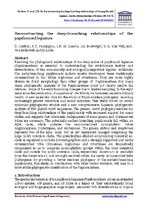| dc.contributor.author | Cardoso, D. | |
| dc.contributor.author | Pennington, R.T. | |
| dc.contributor.author | de Queiroz, L.P. | |
| dc.contributor.author | Boatwright, James S. | |
| dc.contributor.author | van Wyk, Brian Eduard | |
| dc.contributor.author | Wojciechowski, M.F. | |
| dc.contributor.author | Lavin, M. | |
| dc.date.accessioned | 2017-09-13T12:54:12Z | |
| dc.date.available | 2017-09-13T12:54:12Z | |
| dc.date.issued | 2013 | |
| dc.identifier.citation | Cardoso, D. et al. (2013). Reconstructing the deep-braching relationships of the papilionoid legumes. South African Journal of Botany. 89: 58-75 | en_US |
| dc.identifier.issn | 0254-6299 | |
| dc.identifier.uri | https://dx.doi.org/10.1016/j.sajb.2013.05.001 | |
| dc.identifier.uri | http://hdl.handle.net/10566/3193 | |
| dc.description.abstract | Resolving the phylogenetic relationships of the deep nodes of papilionoid legumes (Papilionoideae) is essential to understanding the evolutionary history and diversification of this economically and ecologically important legume subfamily. The early-branching papilionoids include mostly Neotropical trees traditionally circumscribed in the tribes Sophoreae and Swartzieae. They are more highly diverse in floral morphology than other groups of Papilionoideae. For many years, phylogenetic analyses of the Papilionoideae could not clearly resolve the relation- ships of the early-branching lineages due to limited sampling. In the eight years since the publication of Legumes of the World, we have seen an extraordinary wealth of new molecular data for the study of Papilionoideae phylogeny, enabling increasingly greater resolution and many surprises. This study draws on recent molecular phylogenetic studies and a new comprehensive Bayesian phylogenetic analysis of 668 plastid matK sequences. The present matK phylogeny resolves the deep-branching relationships of the papilionoids with increased support for many clades, and suggests that taxonomic realignments of some genera and of numerous tribes are necessary. The potentially earliest-branching papilionoids fall within an ADA clade, which includes the recircumscribed monophyletic tribes Angylocalyceae, Dipterygeae, and Amburanae. The genera Aldina and Amphimas represent two of the nine main but as yet unresolved lineages comprising the large 50-kb inversion clade. The quinolizidine-alkaloid-accumulating Genistoid s.l. clade is expanded to include Dermatophyllum and a strongly supported and newly circumscribed tribe Ormosieae. Sophoreae and Swartzieae are dramatically reorganized so as to comprise mono-phyletic groups within the Core Genistoid clade and outside the 50-kb inversion clade, respectively. Acosmium is excluded from the Genistoids s.l. and strongly resolved within the newly circumscribed tribe Dalbergieae. By providing a better resolved phylogeny of the earliest-branching papilionoids, this study, in combination with other recent evidence, will lead to a more stable phylogenetic classification of the Papilionoideae. | en_US |
| dc.language.iso | en | en_US |
| dc.publisher | Elsevier | en_US |
| dc.subject | Leguminosae | en_US |
| dc.subject | matK | en_US |
| dc.subject | Papilionoideae | en_US |
| dc.subject | Phylogenetic classification | en_US |
| dc.subject | Sophoreae | en_US |
| dc.subject | Swartzieae | en_US |
| dc.title | Reconstructing the deep-branching relationships of the papilionoid legumes | en_US |
| dc.type | Article | en_US |
| dc.privacy.showsubmitter | TRUE | |
| dc.status.ispeerreviewed | TRUE | |
| dc.status.ispeerreviewed | This is the author-version of the article published online at: https://dx.doi.org/10.1016/j.sajb.2013.05.001 | |
| dc.description.accreditation | Web of Science | |

